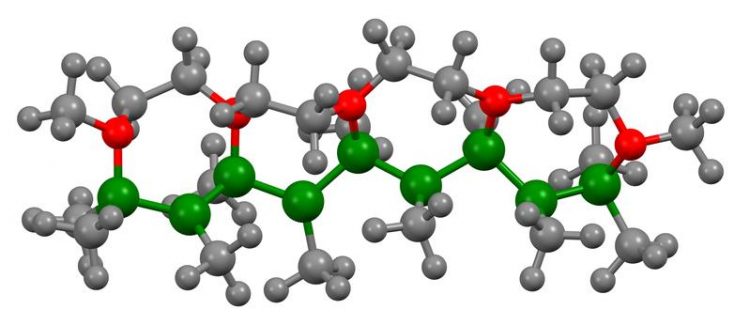Polymers Based on Boron?

How a potential boron polymer could look: boron atoms shown in green, oxygen atoms shown in red, carbon and hydrogen atoms shown in grey. Graphic: Dr. Rian Dewhurst
Plastic bags from polyethylene, packaging from polystyrene, frying pans with Teflon coatings: everyday life is awash with polymers. Chemically, polymers are long, chain-like molecules with backbones based almost exclusively on carbon (and sometimes silicon) atoms. Other types of polymers are rare.
The team of Chemistry Professor Holger Braunschweig at the Julius-Maximilians-Universität Würzburg (JMU) in Bavaria, Germany, have recently set their sights on the production of polymers based on chains of boron atoms. The as-yet-unknown boron polymers are expected to have highly unusual and useful properties – higher electrical conductance than polymers commonly used in the organic electronics industry being just one example.
Proposal to the DFG finds success
Holger Braunschweig's research proposal to the German Research Foundation (DFG) on this topic was successful: For this goal he will receive 1.5 million Euros from the DFG's Reinhart Koselleck program. This program was created to support particularly innovative and risky projects.
With this funding Prof. Braunschweig hopes to develop efficient synthetic strategies to boron polymers. In this respect it is critical to prevent the boron chains from collapsing in on themselves and forming clusters – a tendency that the element boron is famous for. The research team has come up with five promising strategies to form the desired chains. If successful, they will have discovered a fundamentally new class of materials, the potential applications of which could be immense.
Worldwide recognition as boron expert
The Reinhard Koselleck program of the DFG exclusively funds researchers with exceptional scientific track records. Holger Braunschweig is recognized as a worldwide expert in the chemistry of the element boron. His previous work includes a succession of fundamental breakthroughs in this field – including, among others, the synthesis of the first compound with a triple bond between two boron atoms.
For his work, Braunschweig has been distinguished with two ERC Advanced Grants, each coming with 2.5 million Euro of research funding. In 2009 he also received the 2.5 million Euro Leibniz Prize of the DFG.
Contact
Prof. Dr. Holger Braunschweig, Institute for Inorganic Chemistry / Institute for Sustainable Chemistry & Catalysis with Boron, JMU, Tel +49 931 31-85260, h.braunschweig@uni-wuerzburg.de
Media Contact
All latest news from the category: Life Sciences and Chemistry
Articles and reports from the Life Sciences and chemistry area deal with applied and basic research into modern biology, chemistry and human medicine.
Valuable information can be found on a range of life sciences fields including bacteriology, biochemistry, bionics, bioinformatics, biophysics, biotechnology, genetics, geobotany, human biology, marine biology, microbiology, molecular biology, cellular biology, zoology, bioinorganic chemistry, microchemistry and environmental chemistry.
Newest articles

First-of-its-kind study uses remote sensing to monitor plastic debris in rivers and lakes
Remote sensing creates a cost-effective solution to monitoring plastic pollution. A first-of-its-kind study from researchers at the University of Minnesota Twin Cities shows how remote sensing can help monitor and…

Laser-based artificial neuron mimics nerve cell functions at lightning speed
With a processing speed a billion times faster than nature, chip-based laser neuron could help advance AI tasks such as pattern recognition and sequence prediction. Researchers have developed a laser-based…

Optimising the processing of plastic waste
Just one look in the yellow bin reveals a colourful jumble of different types of plastic. However, the purer and more uniform plastic waste is, the easier it is to…



